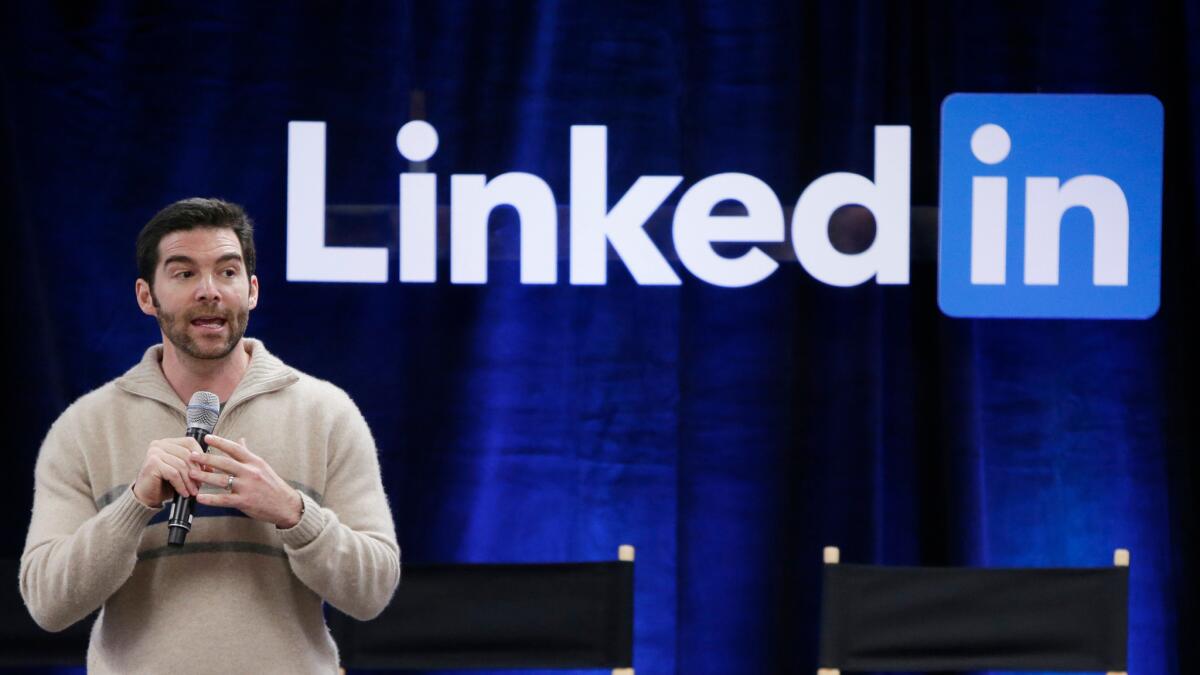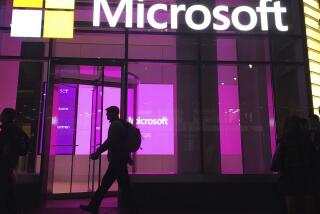Microsoft bolsters its business products by acquiring LinkedIn for $26.2 billion

When newly appointed Chief Executive Satya Nadella spelled out his vision for Microsoft in 2014, he pledged to revive a stagnant technology giant that had been eclipsed by more nimble and more mobile companies.
To do that, he said, âwe must rediscover our soul -- our unique core.â
So where is the unique core of the $392-billion company that brought computers into the home and made Windows the default operating system for nearly two decades? The workplace, apparently.
With Mondayâs $26.2-billion acquisition of professional networking site LinkedIn Corp. -- a deal that marks one of the biggest purchases in the history of the technology industry and the biggest ever for Microsoft -- Nadella further pinned the companyâs future to business software.
It brings together Microsoftâs Internet services and âthe worldâs leading professional network,â Nadella said in a statement.
He described how LinkedInâs database of some 433 million users -- imagine Facebook for the cubicle set -- will complement Microsoftâs workplace products Office 365 and Dynamics businesses. He described the âmagicâ that will happen when data from LinkedIn and Microsoft cross-pollinate. He envisioned how the two companies will âtransform the lives of professionals.â
When PCs were king, Microsoft was the dominant force in computing and the nationâs highest valued company by market capitalization. But as Web browsing moved to mobile devices, Apple and Google overshadowed the Redmond, Wash., firm in both prosperity and prestige.
But the workplace is one place where Microsoft has found staying power. The majority of office computers still use Windows products, with estimates from IT management firms that as many as 90% office computers run the Windows operating system.
The addition of LinkedIn -- which will retain its âdistinct brand, culture and independenceâ after the acquisition, with Chief Executive Jeff Weiner remaining at the helm -- could beef up Microsoftâs work-focused offerings and make them more attractive to businesses and businesspeople.
âIt follows in the pattern of Microsoft trying to use its huge cash flow from its mature business (Windows and Microsoft Office) to grab onto something else that can grow,â said James Angel, a professor of finance at Georgetownâs McDonough School of Business. He compares Microsoftâs move to that of IBM, which in the 1990s pivoted away from its core business of PCs to focus on software for office workers.
While analysts are generally optimistic about the acquisition, Microsoftâs past bets have given business experts reason to be skeptical.
In 2013, Microsoft paid $7.2 billion to acquire Nokiaâs mobile phone business and license all its patents. The deal was widely considered a disaster, with Microsoft gutting the Nokia business and exiting mobile hardware two years later.
Three years earlier, Microsoft acquired Internet communications company Skype for $8.5 billion, the results of which have been underwhelming. Last year, it bought Mojang, the company that developed the video game âMinecraft,â for $2.5 billion. They jury is still out on the success of that move.
âMicrosoft doesnât have a great track record of success with these acquisitions,â Angel said.
LinkedIn is a treasure trove of professional data, according to Gene Marks, founder of the Marks Group PC, a firm that specializes in customer relationship management software. One potential opportunity is Microsoft Dynamics CRM, the customer relationship management platform that lets businesses analyze and manage interactions with customers.
By integrating with LinkedIn, Microsoftâs platform could access frequently updated user and business profiles, as well as information on peopleâs professional connections -- a valuable asset in generating sales leads.
This could help Microsoft fend off competition from a younger rival that has inched into the world of business software: Salesforce.com.
Last year the CRM industry brought in $26 billion in revenue, according to data research firm Gartner, of which Salesforce had 19.7% market share. Microsoft had 4.3%. The industry continues to grow at double digits year over year.
âMicrosoft is looking for a way to defeat Salesforce, and I think theyâve found it,â Marks said.
The acquisition is a âbig and bold stepâ for Microsoft and a âgreat dealâ for LinkedIn, said Gregory Sichenzia, a partner at securities law firm Sichenzia Ross Friedman Ference, who said both companies will breathe new life into each other.
LinkedIn has in recent years struggled to grow its user base and hit revenue targets. The Mountain View, Calif., company attracts 105 million visitors to its site and mobile app every month, compared with Twitterâs 305 million and Facebookâs 1.65 billion monthly users. One of its biggest challenges, analysts say, has been persuading users to log on when they arenât searching for work.
The companyâs stock took a dive in February, falling 43% and wiping out $11 billion in value after it lowered its revenue projections for 2016. Until Mondayâs acquisition news, LinkedInâs stock had spent the last three and a half months depressed. A hacker last month offered for sale more than 100 million LinkedIn passwords.
âA lot of people feel that LinkedIn has gotten stale, and it couldnât grow beyond what itâs already done,â Sichenzia said. âMicrosoft has also become somewhat stale -- itâs not where the excitement is anymore, so Microsoft will be a terrific partner that can grow LinkedIn in ways it couldnât grow itself, and having LinkedIn puts Microsoft at the level of a younger, hipper, more socially relevant company.â
Analysts also speculated that Microsoft has financial incentives for spending big. Mike Wade, a professor of IMD Business School, noted that the company is sitting on $100 billion in cash and short-term investments -- a big weight on the balance sheet.
âThe pressure to spend it or issue a special dividend, as it has done in the past, was mounting,â Wade said. âBetter to spend it than to lose it.â
Microsoft will pay $196 per share of LinkedIn in the all-cash transaction, a 50% premium on LinkedInâs closing stock price of $131.08 on Friday.
Despite the premium, Microsoftâs offer is still significantly lower than LinkedInâs 52-week high of $258 a share.
On Monday, shares of LinkedIn soared $61.13, or 46.6%, to $192.21. Microsoft closed down $1.34, or 2.6%, to $50.14.
The deal has been unanimously approved by both companiesâ boards of directors and is subject to approval by LinkedInâs shareholders and other regulatory approvals. It is expected to close this year.
Twitter: @traceylien
Times staff writer Samantha Masunaga contributed to this report.
ALSO
Are you on track for retirement? Do the math
Key government reports were wrong about methane leaksâ severity, environmental group alleges
UPDATES:
5:32 p.m.: This story has been updated with additional reporting.
12:07 p.m.: This story has been updated with additional reporting, analysis and quotes.
7:50 a.m.: This story has been updated to include information about Microsoftâs acquisition of Nokiaâs mobile phone business.
7:34 a.m.: This story has been updated to include both companiesâ stock prices and information about Microsoftâs past acquisitions.
6:54 a.m.: This story has been updated throughout with additional details.
This article was originally published at 6:06 a.m.
More to Read
Inside the business of entertainment
The Wide Shot brings you news, analysis and insights on everything from streaming wars to production â and what it all means for the future.
You may occasionally receive promotional content from the Los Angeles Times.











